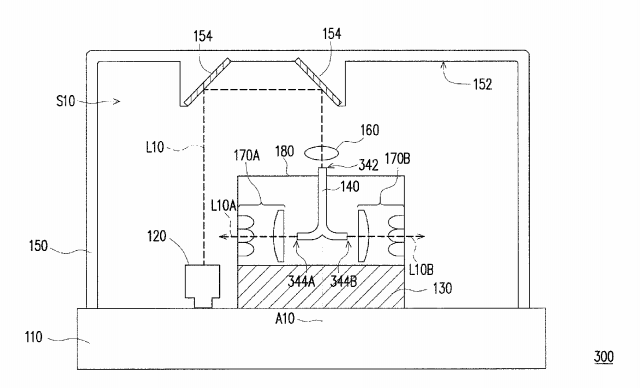HTC Patent | Optical base station
Patent: Optical base station
Publication Number: 10146047
Publication Date: 2018-12-04
Applicants: HTC Corporation

Abstract
An optical base station including a base, a light source, a rotation plate and an optical fiber is provided. The light source is disposed on the base for providing a light beam. The rotation plate is disposed on the base. The optical fiber is disposed on the base and has an input end and a first output end. The rotation plate drives the optical fiber to rotate around a rotation axis. The rotation axis passes through the input end. The light beam enters the optical fiber from the input end and is output from the first output end after being transmitted in the optical fiber.
BACKGROUND
FIELD OF THE INVENTION
The application is directed to a base station and more particularly, to an optical base station.
DESCRIPTION OF RELATED ART
Virtual reality (VR) systems have become one of the major popular techniques available on the market. A user, after wearing a VR apparatus on the head, can view a three dimensional (3D) image with a display portion in front of the eyes, thereby experiencing reality and vividness. However, in order to construct a correct VR space, an optical base station for providing a spatially-positioning datum has to be equipped.
FIG. 1 is a schematic view illustrating a conventional optical base station. Referring to FIG. 1, in order to two-dimensionally scan a space, a conventional optical base 200 uses two rotors 220A and 220B in cooperation with two light sources 210A and 210B. A light beam L20A provided by the light source 210A, after entering the rotor 220A, rotates with the rotor 220A to scan a surrounding space. A light beam L20B provided by the light source 210B, after entering the rotor 220B, rotates with the rotor 220B in a direction different from that of the light beam L20A to scan the surrounding space. However, because the rotors 220A and 220B and the two light sources 210A and 210B are respectively located at the top, the bottom, the left, and the right of the optical base 200, ranges capable of being scanned with the light beams L20A and L20B are restricted by a housing 230 of the optical base 200. Additionally, the two rotors 220A and 220B may also cause difficulty in reducing the volume of the optical base 200 and difficulty in cost down.
FIG. 2 is a schematic cross-sectional view of a single rotor depicted in FIG. 1. Referring to FIG. 2, due to the presence of an assembly tolerance, a transmission path of the light beam L20A may not coincide with a rotation axis A20 of the rotor 220A as what is expected. As such, hitting points of the light beam L20A on the reflector in the rotor 220A may change with rotation of the rotor 220A, which may cause the light beam L20A reflected by the reflector to shift vertically, such that optical scanning stability may be influenced.
SUMMARY
The application provides an optical base station capable of resolving the problem caused by an assembly deviation.
An optical base station including a base, a light source, a rotation plate and an optical fiber is provided by the application. The light source is disposed on the base for providing a light beam. The rotation plate is disposed on the base. The optical fiber is disposed on the base and has an input end and a first output end. The rotation plate drives the optical fiber to rotate around a rotation axis. The rotation axis passes through the input end. The light beam entering the optical fiber from the input end is transmitted in the optical fiber and output from the first output end.
To sum up, in the optical base station of the application, positions where the input end and the first output end of the optical fiber are disposed on the rotation plate are fixed. Thus, the problem of an unstable optical scanning effect caused by the assembly deviation can be prevented.



